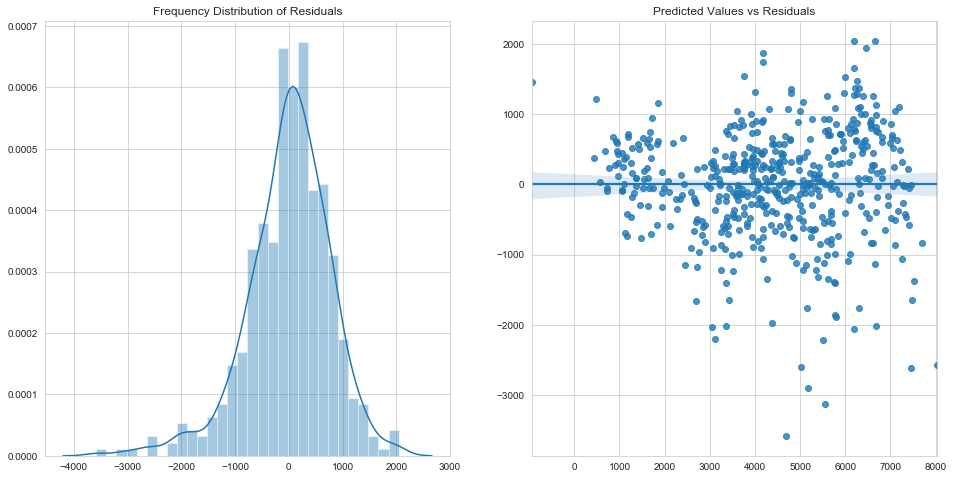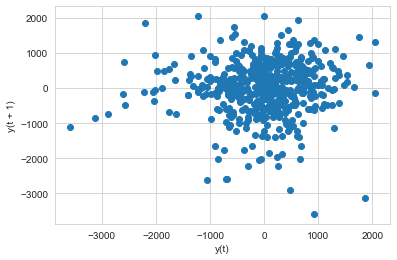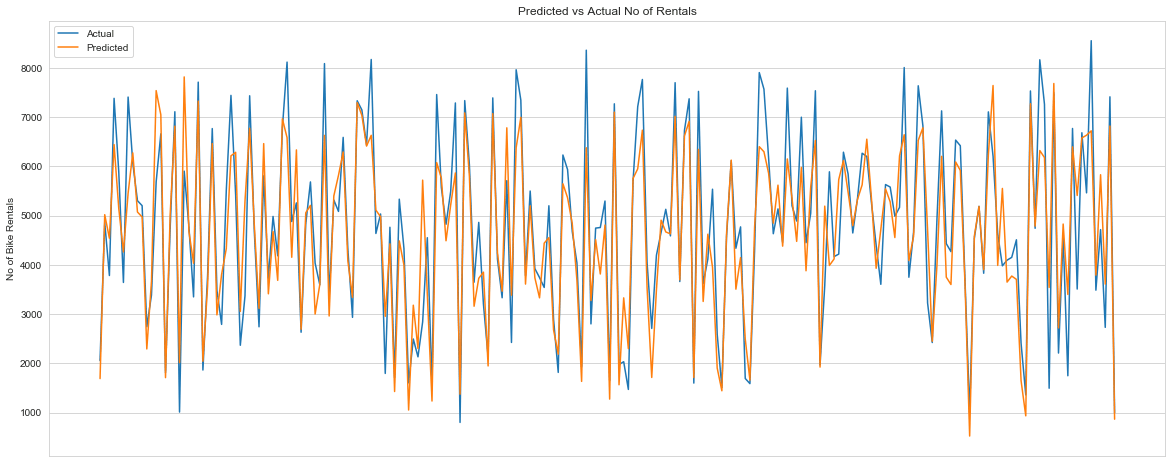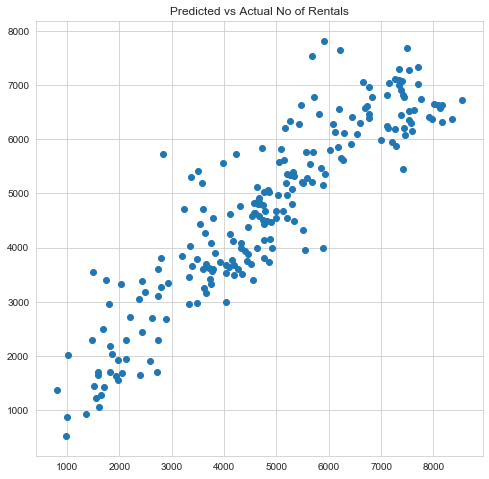Problem Statement
A bike-sharing system is a service in which bikes are made available for shared use to individuals on a short term basis for a price or free. Many bike share systems allow people to borrow a bike from a “dock” which is usually computer-controlled wherein the user enters the payment information, and the system unlocks it. This bike can then be returned to another dock belonging to the same system.
A US bike-sharing provider BoomBikes has recently suffered considerable dips in their revenues due to the ongoing Corona pandemic. The company is finding it very difficult to sustain in the current market scenario. So, it has decided to come up with a mindful business plan to be able to accelerate its revenue as soon as the ongoing lockdown comes to an end, and the economy restores to a healthy state.
In such an attempt, BoomBikes aspires to understand the demand for shared bikes among the people after this ongoing quarantine situation ends across the nation due to Covid-19. They have planned this to prepare themselves to cater to the people’s needs once the situation gets better all around and stand out from other service providers and make huge profits.
They have contracted a consulting company to understand the factors on which the demand for these shared bikes depends. Specifically, they want to understand the factors affecting the demand for these shared bikes in the American market. The company wants to know:
- Which variables are significant in predicting the demand for shared bikes.
- How well those variables describe the bike demands
Based on various meteorological surveys and people’s styles, the service provider firm has gathered a large dataset on daily bike demands across the American market based on some factors.
Business Goals
The company needs to model the demand for shared bikes with the available independent variables. It will be used by the management to understand how exactly the demands vary with different features. They can accordingly manipulate the business strategy to meet the demand levels and meet the customer’s expectations. Further, the model will be a good way for management to understand the demand dynamics of a new market.
Analysis Approach & Conclusions
This problem can be solved using Multiple Linear Regression Analysis. The company requires a two fold solution.
- A model to predict demand with accuracy.
- Insight into the significant relationships that exist between demand and available predictors.
Analysis is carried out using a Mixed Feature Selection Approach. 15 features are selected algorithmically using Recursive Feature Elimination. Further selection is done manually by looking at multicollinearity and statistical significance of features and overall fit of the model. The 10 most significant features to understand demand have been reported.
The data set is randomly divided into training and test data.
Final Model built on training data set explains 84% of the variability and achieves 81% on test data.
The final relationship between demand and predictors is as follows.
cnt= 2392.0791 + 1946.7864yr+ 444.4907Saturday+ 466.0136winter- 890.3115july-1063.6669spring+ 296.8008workingday- 1749.8275hum+ 4471.6602temp- 1110.3191windspeed- 1273.7519light snow/rain
where temp , windspeed and hum are normalized.
Note :
- Data has been cleaned to drop outliers that might affect the model adversely
- The model has been verified for Multicollinearity effects.
- Residual Analysis has been carried out and the model satisfies the assumptions of Linear Regression (Residuals follow a normal distribution, Errors exhibit homoscedasticity)
- Q-Q plot between residual distribution and normal distribution shows that residuals approximately follow a normal distribution. Some points significant deviation which deems further analysis
- Further Lag plot shows there is no auto-correlation in data.
- Model is stable at 81%(+/-14%) coefficient of determination at 95% CI, ascertained through cross validation.
- Features in the order of influence has been reported by standardizing all predictor values.
- Outliers dropped during Data Understanding phase deems further analysis from business perspective.
Reading and Understanding Data
1data = pd.read_csv('./day.csv')
1data.head()
Data Quality Checks
1data.info()
1<class 'pandas.core.frame.DataFrame'>2RangeIndex: 730 entries, 0 to 7293Data columns (total 16 columns):4 # Column Non-Null Count Dtype5--- ------ -------------- -----6 0 instant 730 non-null int647 1 dteday 730 non-null object8 2 season 730 non-null int649 3 yr 730 non-null int6410 4 mnth 730 non-null int6411 5 holiday 730 non-null int6412 6 weekday 730 non-null int6413 7 workingday 730 non-null int6414 8 weathersit 730 non-null int6415 9 temp 730 non-null float6416 10 atemp 730 non-null float6417 11 hum 730 non-null float6418 12 windspeed 730 non-null float6419 13 casual 730 non-null int6420 14 registered 730 non-null int6421 15 cnt 730 non-null int6422dtypes: float64(4), int64(11), object(1)23memory usage: 91.4+ KB
- No missing values
Visualizing Continuous Variables
1# dropping `instant`,`dteday`,`casual`,`registered`23data = data.drop(columns=['instant','dteday','casual','registered'])
These variables were dropped since instant is the just the serial number of the record,
dteday is redundant coz the required data for analysis is contained in mnth,yr
casual + registered = cnt
1# summary statistics of numerical variables2data[['temp','atemp','hum','windspeed']].describe()
1# Scatter Plots of Continuous variables vs 'cnt'2sns.set_style("whitegrid")3sns.pairplot(data=data,x_vars=['temp','atemp','hum','windspeed'],y_vars='cnt',kind='scatter',height=5,aspect=1);

- The number of rentals per day seem to be increasing with temperature and adjusted temperature
- adjusted temperature and temperature have similar trends
- temp vs cnt has two outliers between 15 and 30
- atemp vs cnt has two outliers between 20 and 35
- hum vs cnt has two outliers below 20
- windspeed vs cnt has one outlier above 30
Outliers in Continuous Variables vs cnt
1## Dropping outliers in continuous variables2# outliers in temp3data = data.drop(index = data[(data['temp'] > 15) & (data['temp'] < 20) & (data['cnt'] < 100)].index)4data = data.drop(index = data[(data['temp'] > 25) & (data['temp'] < 30) & (data['cnt'] < 2000)].index)567# outliers in atemp8data = data.drop(index = data[(data['atemp'] > 20) & (data['atemp'] < 25) & (data['cnt'] < 100)].index)9data = data.drop(index = data[(data['atemp'] > 30) & (data['atemp'] < 35) & (data['cnt'] < 2000)].index)101112#outliers in hum13data = data.drop(index = data[(data['hum'] < 20)].index)1415#outliers in windspeed16data = data.drop(index = data[(data['windspeed'] > 30)].index)
1# Looking at correlation with continuous variables2correlation = data[['temp','atemp','hum','windspeed','cnt']].corr()['cnt'].apply(lambda x : round(x,4))3correlation = pd.DataFrame(correlation).sort_values(by='cnt',ascending=False)4correlation.drop(index=['cnt'],inplace=True)5# dropping registered,casual, instant6correlation.style.background_gradient(cmap='GnBu')
- There’s no signifcant correlation between
atempandhum,windspeed. - Hence these are not dropped for now.
Visualizing Categorical Variables
1# Converting variables into categorical type2data[['season','weathersit','mnth']] = data[['season','weathersit','mnth']].astype('category')
1# Unique values in each categorical variable / [To check for disguised missing values]2cat_vars = ['season','yr','mnth','holiday','weekday','workingday','weathersit']3for i in cat_vars :4 print('Unique values in ',i, data[i].unique())
1Unique values in season [1, 2, 3, 4]2Categories (4, int64): [1, 2, 3, 4]3Unique values in yr [0 1]4Unique values in mnth [1, 2, 3, 4, 5, ..., 8, 9, 10, 11, 12]5Length: 126Categories (12, int64): [1, 2, 3, 4, ..., 9, 10, 11, 12]7Unique values in holiday [0 1]8Unique values in weekday [6 0 1 2 3 4 5]9Unique values in workingday [0 1]10Unique values in weathersit [2, 1, 3]11Categories (3, int64): [2, 1, 3]
- No disguised missing values exist
1# Replacing numbers with labels2season_labels = {3 1 : 'spring',4 2 : 'summer',5 3 : 'fall',6 4 : 'winter'7}89mnth_labels = {10 1 : 'january',11 2 : 'february',12 3 : 'march',13 4 : 'april',14 5 : 'may',15 6 : 'june',16 7 : 'july',17 8 : 'august',18 9 : 'september',19 10 : 'october',20 11 : 'november',21 12 : 'december'22}2324weekday_labels = { # considering the first row of dteday to be 01-01-201125 0 : 'Sunday',26 1 : 'Monday',27 2 : 'Tuesday',28 3 : 'Wednesday',29 4 : 'Thursday',30 5 : 'Friday',31 6 : 'Saturday'32}3334weathersit_labels = {35 1 : 'clear',36 2 : 'cloudy',37 3 : 'light snow/rain'38}3940# replacing numerals with labels41data['season'] = data['season'].replace(season_labels)42data['mnth'] = data['mnth'].replace(mnth_labels)43data['weekday'] = data['weekday'].replace(weekday_labels)44data['weathersit'] = data['weathersit'].replace(weathersit_labels)4546data.head()
1cat_vars = ['season','yr','mnth','holiday','weekday', 'workingday','weathersit']2data1 = data[cat_vars]3data1.loc[:,'cnt'] = data['cnt'].values4data1[['yr','holiday','workingday']] = data1[['yr','holiday','workingday']].astype('category')5plot_dim = [3,3]6fig,axs = plt.subplots(*plot_dim)7fig.set_figheight(15)8fig.set_figwidth(20)9for i in range(plot_dim[0]) :10 for j in range(plot_dim[1]) :11 axs[i,j].set(title = i*plot_dim[1]+j)12 sns.boxplot(data=data1,x='cnt',y=cat_vars[i*plot_dim[1]+j],width=0.4,ax=axs[i,j])13 if i*plot_dim[1]+j == 6 :14 break15axs[2,1].set_axis_off()16axs[2,2].set_axis_off()

- From the season vs rentals per day plot , fall has the highest average rentals followed by summer.
- Looking at year by year rentals, 2019 has had a median 2000 increase in rentals compared to 2018.
- From the month wise plot, September has the highest rentals, followed by the two months surrounding it. It seems like the trend is explained by seasonal rentals too
- Holidays show lower rental count compared to working days, with greater variability in demand on holidays.
- There is no significant difference between rentals vs weekdays, except that Thursdays and sundays have a higher variation in rentals than others.
Outliers in Categorical Variables vs cnt
1# Dropping outliers in Categorical Variables2data = data.drop(index = data[(data['season'] == 'spring') & (data['cnt'] > 7000)].index)
Correlation
1# correlation among variables2plt.figure(figsize=[10,10])3sns.heatmap(data.corr(),cmap='GnBu',center=0,annot=True)
1<matplotlib.axes._subplots.AxesSubplot at 0x7fde4bfdd610>

- Highest correlation with
cntis seen intempfollowed byyr
Data Preparation
Creating Indictor Variables
1# creating indicator variable columns2season_indicators = pd.get_dummies(data['season'],drop_first=True)3mnth_indicators = pd.get_dummies(data['mnth'],drop_first=True)4weekday_indicators = pd.get_dummies(data['weekday'],drop_first=True)5weathersit_indicators = pd.get_dummies(data['weathersit'],drop_first=True)
1# adding indicator variable columns to the dataset . Dropping original columns2data = pd.concat([data,season_indicators,mnth_indicators,weekday_indicators,weathersit_indicators],axis=1)3data = data.drop(columns=['season','mnth','weekday','weathersit'])
1data.head()
1data.columns
1Index(['yr', 'holiday', 'workingday', 'temp', 'hum', 'windspeed', 'cnt',2 'spring', 'summer', 'winter', 'august', 'december', 'february',3 'january', 'july', 'june', 'march', 'may', 'november', 'october',4 'september', 'Monday', 'Saturday', 'Sunday', 'Thursday', 'Tuesday',5 'Wednesday', 'cloudy', 'light snow/rain'],6 dtype='object')
| Variable | Reference Label |
| season | fall |
| mnth | april |
| weekday | Friday |
| weathersit | clear |
Splitting the data set into Test & Train subsets
1from sklearn.model_selection import train_test_split
1dtrain,dtest = train_test_split(data,train_size=0.7,test_size=0.3,random_state=120)
Scaling Numerical Features
1# normalization of continuous variables2from sklearn.preprocessing import MinMaxScaler3numerical_scaler = MinMaxScaler()4num_vars = ['temp','hum','windspeed']56numerical_scaler.fit(dtrain[num_vars])7dtrain[num_vars] = numerical_scaler.transform(dtrain[num_vars])
X_train , y_train
1y_train = dtrain.pop('cnt')2X_train = dtrain
1y_train.head()
1231 51912717 52673107 34294595 45495485 57406Name: cnt, dtype: int64
1X_train.head()
1X_train.columns
1Index(['yr', 'holiday', 'workingday', 'temp', 'hum', 'windspeed', 'spring',2 'summer', 'winter', 'august', 'december', 'february', 'january', 'july',3 'june', 'march', 'may', 'november', 'october', 'september', 'Monday',4 'Saturday', 'Sunday', 'Thursday', 'Tuesday', 'Wednesday', 'cloudy',5 'light snow/rain'],6 dtype='object')
Modelling
Approach
- A mixed approach is followed.
- 15 Best columns are chosen using RFE
- And then p-value method is followed for further elimination.
Recursive Feature Elimination
1# Selecting 15 Features using RFE23from sklearn.feature_selection import RFE4from sklearn.linear_model import LinearRegression56lr_estimator = LinearRegression()7rfe = RFE(lr_estimator,n_features_to_select=15, step=1)8selector = rfe.fit(X_train,y_train)
1# RFE Feature Ranking2rfe_ranking = pd.DataFrame({'rank' : selector.ranking_, 'support': selector.support_, 'features' : X_train.columns}).sort_values(by='rank',ascending=True)3rfe_ranking
1# Selected Features2selected_features = rfe_ranking.loc[rfe_ranking['rank'] == 1,'features'].values3selected_features
1array(['yr', 'Sunday', 'Saturday', 'november', 'january', 'december',2 'winter', 'july', 'spring', 'holiday', 'workingday', 'hum', 'temp',3 'windspeed', 'light snow/rain'], dtype=object)
Manual Elimination
1# Following a stepwise elimination2import statsmodels.api as sm3def ols_fit(y,X) :4 X_train_sm = sm.add_constant(X)5 model = sm.OLS(y,X_train_sm).fit()6 print(model.summary())7 return model8def vif(X) :9 df = sm.add_constant(X)10 vif = [variance_inflation_factor(df.values,i) for i in range(df.shape[1])]11 vif_frame = pd.DataFrame({'vif' : vif[0:]},index = df.columns).reset_index()12 print(vif_frame.sort_values(by='vif',ascending=False))
Model 1
- Using features selected by RFE : ‘yr’, ‘Sunday’, ‘Saturday’, ‘november’, ‘january’, ‘december’, ‘winter’, ‘july’, ‘spring’, ‘holiday’, ‘workingday’, ‘hum’, ‘temp’, ‘windspeed’, ‘light snow/rain’
1features_1 = selected_features2ols_fit(y_train,X_train[features_1])3vif(X_train[selected_features])
1OLS Regression Results2==============================================================================3Dep. Variable: cnt R-squared: 0.8444Model: OLS Adj. R-squared: 0.8405Method: Least Squares F-statistic: 189.86Date: Thu, 30 Jul 2020 Prob (F-statistic): 9.27e-1887Time: 20:41:57 Log-Likelihood: -4072.48No. Observations: 506 AIC: 8175.9Df Residuals: 491 BIC: 8238.10Df Model: 1411Covariance Type: nonrobust12===================================================================================13 coef std err t P>|t| [0.025 0.975]14-----------------------------------------------------------------------------------15const 2278.2820 192.838 11.815 0.000 1899.393 2657.17116yr 1959.7590 69.543 28.180 0.000 1823.120 2096.39817Sunday 497.0421 97.123 5.118 0.000 306.214 687.87118Saturday 874.2613 95.093 9.194 0.000 687.422 1061.10119november -617.4927 158.994 -3.884 0.000 -929.885 -305.10020january -391.9320 149.160 -2.628 0.009 -685.002 -98.86221december -475.8630 142.634 -3.336 0.001 -756.112 -195.61422winter 687.2832 121.588 5.653 0.000 448.387 926.18023july -804.3128 141.415 -5.688 0.000 -1082.166 -526.45924spring -1010.6061 134.437 -7.517 0.000 -1274.749 -746.46425holiday 165.4153 160.101 1.033 0.302 -149.152 479.98226workingday 741.5633 73.655 10.068 0.000 596.846 886.28027hum -1782.6033 198.667 -8.973 0.000 -2172.947 -1392.26028temp 4036.2727 275.497 14.651 0.000 3494.974 4577.57129windspeed -1167.6983 188.628 -6.190 0.000 -1538.315 -797.08130light snow/rain -1276.7947 234.425 -5.446 0.000 -1737.395 -816.19431==============================================================================32Omnibus: 74.940 Durbin-Watson: 1.92033Prob(Omnibus): 0.000 Jarque-Bera (JB): 164.19134Skew: -0.800 Prob(JB): 2.22e-3635Kurtosis: 5.286 Cond. No. 6.67e+1536==============================================================================3738Warnings:39[1] Standard Errors assume that the covariance matrix of the errors is correctly specified.40[2] The smallest eigenvalue is 3.03e-29. This might indicate that there are41strong multicollinearity problems or that the design matrix is singular.42 index vif432 Sunday inf443 Saturday inf4510 holiday inf4611 workingday inf4713 temp 3.530342489 spring 2.972066497 winter 2.265754505 january 1.667765514 november 1.649107526 december 1.384399538 july 1.3327865412 hum 1.3020615515 light snow/rain 1.1790135614 windspeed 1.161178571 yr 1.035227580 const 0.000000
Model 2 :
- Dropping
holidaybecause of high p-value
1del_feature = 'holiday'2selected_features = selected_features[selected_features!=del_feature]3ols_fit(y_train,X_train[selected_features])4vif(X_train[selected_features])
1OLS Regression Results2==============================================================================3Dep. Variable: cnt R-squared: 0.8444Model: OLS Adj. R-squared: 0.8405Method: Least Squares F-statistic: 189.86Date: Thu, 30 Jul 2020 Prob (F-statistic): 9.27e-1887Time: 20:41:57 Log-Likelihood: -4072.48No. Observations: 506 AIC: 8175.9Df Residuals: 491 BIC: 8238.10Df Model: 1411Covariance Type: nonrobust12===================================================================================13 coef std err t P>|t| [0.025 0.975]14-----------------------------------------------------------------------------------15const 2443.6973 302.113 8.089 0.000 1850.103 3037.29116yr 1959.7590 69.543 28.180 0.000 1823.120 2096.39817Sunday 331.6268 208.945 1.587 0.113 -78.910 742.16418Saturday 708.8460 208.062 3.407 0.001 300.043 1117.64919november -617.4927 158.994 -3.884 0.000 -929.885 -305.10020january -391.9320 149.160 -2.628 0.009 -685.002 -98.86221december -475.8630 142.634 -3.336 0.001 -756.112 -195.61422winter 687.2832 121.588 5.653 0.000 448.387 926.18023july -804.3128 141.415 -5.688 0.000 -1082.166 -526.45924spring -1010.6061 134.437 -7.517 0.000 -1274.749 -746.46425workingday 576.1480 191.468 3.009 0.003 199.950 952.34626hum -1782.6033 198.667 -8.973 0.000 -2172.947 -1392.26027temp 4036.2727 275.497 14.651 0.000 3494.974 4577.57128windspeed -1167.6983 188.628 -6.190 0.000 -1538.315 -797.08129light snow/rain -1276.7947 234.425 -5.446 0.000 -1737.395 -816.19430==============================================================================31Omnibus: 74.940 Durbin-Watson: 1.92032Prob(Omnibus): 0.000 Jarque-Bera (JB): 164.19133Skew: -0.800 Prob(JB): 2.22e-3634Kurtosis: 5.286 Cond. No. 20.635==============================================================================3637Warnings:38[1] Standard Errors assume that the covariance matrix of the errors is correctly specified.39 index vif400 const 78.2275794110 workingday 6.747604423 Saturday 4.580552432 Sunday 4.3527884412 temp 3.530342459 spring 2.972066467 winter 2.265754475 january 1.667765484 november 1.649107496 december 1.384399508 july 1.3327865111 hum 1.3020615214 light snow/rain 1.1790135313 windspeed 1.161178541 yr 1.035227
Model 3 :
- Dropping
Sundaybecause of high p-value
1del_feature = 'Sunday'2selected_features = selected_features[selected_features!=del_feature]3ols_fit(y_train,X_train[selected_features])4vif(X_train[selected_features])
1OLS Regression Results2==============================================================================3Dep. Variable: cnt R-squared: 0.8434Model: OLS Adj. R-squared: 0.8395Method: Least Squares F-statistic: 203.66Date: Thu, 30 Jul 2020 Prob (F-statistic): 2.22e-1887Time: 20:41:57 Log-Likelihood: -4073.78No. Observations: 506 AIC: 8175.9Df Residuals: 492 BIC: 8234.10Df Model: 1311Covariance Type: nonrobust12===================================================================================13 coef std err t P>|t| [0.025 0.975]14-----------------------------------------------------------------------------------15const 2717.6842 248.317 10.944 0.000 2229.791 3205.57816yr 1958.8083 69.648 28.124 0.000 1821.964 2095.65217Saturday 442.9774 123.597 3.584 0.000 200.134 685.82018november -627.3327 159.118 -3.943 0.000 -939.968 -314.69819january -391.6152 149.390 -2.621 0.009 -685.136 -98.09520december -485.7607 142.718 -3.404 0.001 -766.172 -205.35021winter 687.9955 121.774 5.650 0.000 448.733 927.25822july -808.0743 141.613 -5.706 0.000 -1086.316 -529.83323spring -1018.8530 134.544 -7.573 0.000 -1283.204 -754.50224workingday 310.9383 93.623 3.321 0.001 126.989 494.88825hum -1777.8858 198.952 -8.936 0.000 -2168.785 -1386.98626temp 4023.0506 275.796 14.587 0.000 3481.168 4564.93327windspeed -1166.7398 188.918 -6.176 0.000 -1537.925 -795.55528light snow/rain -1274.2371 234.781 -5.427 0.000 -1735.535 -812.93929==============================================================================30Omnibus: 76.586 Durbin-Watson: 1.90731Prob(Omnibus): 0.000 Jarque-Bera (JB): 168.96432Skew: -0.814 Prob(JB): 2.04e-3733Kurtosis: 5.316 Cond. No. 17.634==============================================================================3536Warnings:37[1] Standard Errors assume that the covariance matrix of the errors is correctly specified.38 index vif390 const 52.6861074011 temp 3.527114418 spring 2.967626426 winter 2.265723434 january 1.667762443 november 1.646599452 Saturday 1.611416469 workingday 1.608346475 december 1.381753487 july 1.3324124910 hum 1.3017695013 light snow/rain 1.1789575112 windspeed 1.161167521 yr 1.035151
Model 4
- Dropping
januarybecause this information might also be contained inwinter.
1del_feature = 'january'2selected_features = selected_features[selected_features!=del_feature]3ols_fit(y_train,X_train[selected_features])4vif(X_train[selected_features])
1OLS Regression Results2==============================================================================3Dep. Variable: cnt R-squared: 0.8414Model: OLS Adj. R-squared: 0.8375Method: Least Squares F-statistic: 217.46Date: Thu, 30 Jul 2020 Prob (F-statistic): 4.41e-1887Time: 20:41:58 Log-Likelihood: -4077.28No. Observations: 506 AIC: 8180.9Df Residuals: 493 BIC: 8235.10Df Model: 1211Covariance Type: nonrobust12===================================================================================13 coef std err t P>|t| [0.025 0.975]14-----------------------------------------------------------------------------------15const 2563.5282 242.686 10.563 0.000 2086.701 3040.35516yr 1951.9279 70.012 27.880 0.000 1814.370 2089.48617Saturday 437.2585 124.312 3.517 0.000 193.013 681.50418november -576.6481 158.877 -3.630 0.000 -888.808 -264.48919december -380.3554 137.749 -2.761 0.006 -651.004 -109.70720winter 696.8818 122.450 5.691 0.000 456.294 937.47021july -846.1814 141.702 -5.972 0.000 -1124.595 -567.76822spring -1101.5863 131.566 -8.373 0.000 -1360.086 -843.08723workingday 310.1011 94.178 3.293 0.001 125.061 495.14124hum -1775.7238 200.131 -8.873 0.000 -2168.939 -1382.50825temp 4232.4252 265.545 15.939 0.000 3710.686 4754.16426windspeed -1126.2015 189.402 -5.946 0.000 -1498.335 -754.06827light snow/rain -1259.9614 236.112 -5.336 0.000 -1723.871 -796.05228==============================================================================29Omnibus: 70.215 Durbin-Watson: 1.92330Prob(Omnibus): 0.000 Jarque-Bera (JB): 144.73031Skew: -0.775 Prob(JB): 3.74e-3232Kurtosis: 5.112 Cond. No. 16.933==============================================================================3435Warnings:36[1] Standard Errors assume that the covariance matrix of the errors is correctly specified.37 index vif380 const 49.7313313910 temp 3.231303407 spring 2.804334415 winter 2.263968423 november 1.622287432 Saturday 1.610914448 workingday 1.608327456 july 1.318372469 hum 1.301747474 december 1.2720744812 light snow/rain 1.1783234911 windspeed 1.153386501 yr 1.033680
Model 5
- Dropping
decemberbecause this information might also be contained inwinter.
1del_feature = 'december'2selected_features = selected_features[selected_features!=del_feature]3ols_fit(y_train,X_train[selected_features])4vif(X_train[selected_features])
1OLS Regression Results2==============================================================================3Dep. Variable: cnt R-squared: 0.8394Model: OLS Adj. R-squared: 0.8355Method: Least Squares F-statistic: 233.36Date: Thu, 30 Jul 2020 Prob (F-statistic): 1.22e-1877Time: 20:41:58 Log-Likelihood: -4081.18No. Observations: 506 AIC: 8186.9Df Residuals: 494 BIC: 8237.10Df Model: 1111Covariance Type: nonrobust12===================================================================================13 coef std err t P>|t| [0.025 0.975]14-----------------------------------------------------------------------------------15const 2484.0272 242.583 10.240 0.000 2007.406 2960.64816yr 1945.4495 70.440 27.619 0.000 1807.051 2083.84817Saturday 435.8371 125.141 3.483 0.001 189.962 681.71218november -443.0313 152.340 -2.908 0.004 -742.345 -143.71819winter 603.4461 118.468 5.094 0.000 370.683 836.20920july -874.0132 142.287 -6.143 0.000 -1153.576 -594.45021spring -1106.1972 132.435 -8.353 0.000 -1366.402 -845.99222workingday 296.4789 94.677 3.131 0.002 110.459 482.49923hum -1801.9289 201.242 -8.954 0.000 -2197.325 -1406.53324temp 4372.9630 262.363 16.668 0.000 3857.478 4888.44825windspeed -1096.9814 190.369 -5.762 0.000 -1471.015 -722.94826light snow/rain -1259.4132 237.690 -5.299 0.000 -1726.420 -792.40627==============================================================================28Omnibus: 67.769 Durbin-Watson: 1.91429Prob(Omnibus): 0.000 Jarque-Bera (JB): 129.54930Skew: -0.778 Prob(JB): 7.39e-2931Kurtosis: 4.929 Cond. No. 16.732==============================================================================3334Warnings:35[1] Standard Errors assume that the covariance matrix of the errors is correctly specified.36 index vif370 const 49.031354389 temp 3.112593396 spring 2.803882404 winter 2.091074412 Saturday 1.610886427 workingday 1.603914433 november 1.471790445 july 1.311701458 hum 1.2988204611 light snow/rain 1.1783224710 windspeed 1.149786481 yr 1.032520
Model 6
- Dropping
novemberbecause this information might also be contained inwinter.
1del_feature = 'november'2selected_features = selected_features[selected_features!=del_feature]3final_model = ols_fit(y_train,X_train[selected_features])4vif(X_train[selected_features])
1OLS Regression Results2==============================================================================3Dep. Variable: cnt R-squared: 0.8364Model: OLS Adj. R-squared: 0.8335Method: Least Squares F-statistic: 252.06Date: Thu, 30 Jul 2020 Prob (F-statistic): 4.89e-1877Time: 20:41:58 Log-Likelihood: -4085.38No. Observations: 506 AIC: 8193.9Df Residuals: 495 BIC: 8239.10Df Model: 1011Covariance Type: nonrobust12===================================================================================13 coef std err t P>|t| [0.025 0.975]14-----------------------------------------------------------------------------------15const 2392.0791 242.318 9.872 0.000 1915.980 2868.17816yr 1946.7864 70.967 27.432 0.000 1807.353 2086.22017Saturday 444.4907 126.045 3.526 0.000 196.842 692.13918winter 466.0136 109.450 4.258 0.000 250.970 681.05719july -890.3115 143.244 -6.215 0.000 -1171.752 -608.87120spring -1063.6669 132.613 -8.021 0.000 -1324.220 -803.11421workingday 296.8008 95.388 3.112 0.002 109.386 484.21622hum -1749.8275 201.947 -8.665 0.000 -2146.607 -1353.04823temp 4471.6602 262.111 17.060 0.000 3956.673 4986.64824windspeed -1110.3191 191.742 -5.791 0.000 -1487.049 -733.59025light snow/rain -1273.7519 239.422 -5.320 0.000 -1744.160 -803.34426==============================================================================27Omnibus: 69.587 Durbin-Watson: 1.89828Prob(Omnibus): 0.000 Jarque-Bera (JB): 136.27629Skew: -0.788 Prob(JB): 2.56e-3030Kurtosis: 4.995 Cond. No. 16.531==============================================================================3233Warnings:34[1] Standard Errors assume that the covariance matrix of the errors is correctly specified.35 index vif360 const 48.198446378 temp 3.060511385 spring 2.769692393 winter 1.758336402 Saturday 1.609975416 workingday 1.603912424 july 1.309666437 hum 1.2885264410 light snow/rain 1.177815459 windspeed 1.149118461 yr 1.032476
Verifying MultiCollinearity
1vif(X_train[selected_features])
1index vif20 const 48.19844638 temp 3.06051145 spring 2.76969253 winter 1.75833662 Saturday 1.60997576 workingday 1.60391284 july 1.30966697 hum 1.2885261010 light snow/rain 1.177815119 windspeed 1.149118121 yr 1.032476
- VIF < 5 for selected features. No significant multicollinearity observed. Similar indicating comparison of R-squared and adjusted R-squared.
Final Model
1final_model = ols_fit(y_train,X_train[selected_features])
1OLS Regression Results2==============================================================================3Dep. Variable: cnt R-squared: 0.8364Model: OLS Adj. R-squared: 0.8335Method: Least Squares F-statistic: 252.06Date: Thu, 30 Jul 2020 Prob (F-statistic): 4.89e-1877Time: 20:41:58 Log-Likelihood: -4085.38No. Observations: 506 AIC: 8193.9Df Residuals: 495 BIC: 8239.10Df Model: 1011Covariance Type: nonrobust12===================================================================================13 coef std err t P>|t| [0.025 0.975]14-----------------------------------------------------------------------------------15const 2392.0791 242.318 9.872 0.000 1915.980 2868.17816yr 1946.7864 70.967 27.432 0.000 1807.353 2086.22017Saturday 444.4907 126.045 3.526 0.000 196.842 692.13918winter 466.0136 109.450 4.258 0.000 250.970 681.05719july -890.3115 143.244 -6.215 0.000 -1171.752 -608.87120spring -1063.6669 132.613 -8.021 0.000 -1324.220 -803.11421workingday 296.8008 95.388 3.112 0.002 109.386 484.21622hum -1749.8275 201.947 -8.665 0.000 -2146.607 -1353.04823temp 4471.6602 262.111 17.060 0.000 3956.673 4986.64824windspeed -1110.3191 191.742 -5.791 0.000 -1487.049 -733.59025light snow/rain -1273.7519 239.422 -5.320 0.000 -1744.160 -803.34426==============================================================================27Omnibus: 69.587 Durbin-Watson: 1.89828Prob(Omnibus): 0.000 Jarque-Bera (JB): 136.27629Skew: -0.788 Prob(JB): 2.56e-3030Kurtosis: 4.995 Cond. No. 16.531==============================================================================3233Warnings:34[1] Standard Errors assume that the covariance matrix of the errors is correctly specified.
- 10 features have been selected.
- All the features are statistically significant [low p-value]
- The model over is a good fit with Prob (F-statistic): 4.89e-187
- The model explains 83.6% variability in the training data. Adjusted R-square being 83.3%
Residual Analysis
1# Residual Analysis of Trained Data2X_train_sm = sm.add_constant(X_train[selected_features])34y_train_pred = final_model.predict(X_train_sm)5fig,ax = plt.subplots(1,2)6fig.set_figheight(8)7fig.set_figwidth(16)89ax[0].set(title='Frequency Distribution of Residuals')10sns.distplot(y_train-y_train_pred, bins=30, ax=ax[0])1112ax[1].set(title='Predicted Values vs Residuals')13\14sns.regplot(y_train_pred,y_train-y_train_pred,ax=ax[1])15plt.show()

1# Mean of Residuals2(y_train-y_train_pred).mean()
14.763163951972846e-12
- Residual errors follow a normal distribution with mean=0
- Variance of Errors doesnt follow any trends
- Residual errors are independent of each other since the Predicted values vs Residuals plot doesn’t show any trend.
1# Verifying the normality of distribution of residuals2mean = (y_train-y_train_pred).mean()3std = (y_train-y_train_pred).std()45ref_normal = np.random.normal(mean,std,(y_train-y_train_pred).shape[0])678percs = np.linspace(0,100,21)9qn_ref_normal = np.percentile(ref_normal, percs)10qn_residual = np.percentile(y_train - y_train_pred , percs)1112plt.plot(qn_ref_normal,qn_residual, ls="", marker="o")1314x = np.linspace(np.min((qn_ref_normal.min(),qn_residual.min())), np.max((qn_ref_normal.max(),qn_residual.max())))15m = plt.plot(x,x, color="k", ls="--")16plt.title('Q-Q Plot : Reference Normal vs Distribution of Residuals ')17plt.savefig('q-q-plot.png')18plt.show()

- This plot further shows that the residual distribution is approximately normal for all test data with values within range of training data.
1# lag plot to assess independence of data points2from pandas.plotting import lag_plot3lag_plot(y_train-y_train_pred)
1<matplotlib.axes._subplots.AxesSubplot at 0x7fde4fb985d0>

- Lagplot of residuals shows no trend. Hence the error terms have constant variance
Hence, assumptions of Linear Regression are satisfied by this model
Prediction
1y_test = dtest.pop('cnt')2X_test = dtest3X_test[num_vars] = numerical_scaler.transform(X_test[num_vars])4X_test = X_test[selected_features]
1X_test = sm.add_constant(X_test)2y_test_pred = final_model.predict(X_test)
Model Evaluation
1# Plotting Actual vs Predicted No of rentals2fig,ax = plt.subplots()3fig.set_figheight(8)4fig.set_figwidth(20)5l1,=ax.plot(range(len(y_test)),y_test)6l2, = ax.plot(range(len(y_test_pred)),y_test_pred)7plt.legend([l1,l2],['Actual','Predicted'])8plt.title('Predicted vs Actual No of Rentals');9plt.ylabel('No of Bike Rentals')10plt.xticks([])11plt.show()1213plt.figure(figsize=[8,8])14plt.scatter(y_test,y_test_pred);15plt.title('Predicted vs Actual No of Rentals');


- Predicted vs observed value plots shows that the model is reasonably accurate.
1from sklearn.metrics import mean_squared_error,r2_score2mse = mean_squared_error(y_test, y_test_pred)3rsquared_test = r2_score(y_test, y_test_pred)4rsquared_train = r2_score(y_train, y_train_pred)5print('R-squared for train data:',round(rsquared_train,2))6print('R-squared for test data:',round(rsquared_test,2))7print('Mean Squared Error',round(mse,3))
1R-squared for train data: 0.842R-squared for test data: 0.813Mean Squared Error 666097.695
Model Stability
1# R-square using cross validation23from sklearn.model_selection import cross_val_score4from sklearn.linear_model import LinearRegression5lr = LinearRegression()6clr = cross_val_score(lr,X_train[selected_features],y_train,cv=10, scoring='r2')7clr
1array([0.76577509, 0.89378885, 0.73439962, 0.87831664, 0.84127272,2 0.85375903, 0.87521829, 0.68697543, 0.73861901, 0.87571386])
1print("R-square at 0.95 confidence level : %0.2f (+/- %0.2f)" % (clr.mean(), clr.std() * 2))
1R-square at 0.95 confidence level : 0.81 (+/- 0.14)
1selected_features
1array(['yr', 'Saturday', 'winter', 'july', 'spring', 'workingday', 'hum',2 'temp', 'windspeed', 'light snow/rain'], dtype=object)
Top Features
1# standardizing numerical variables23from sklearn.preprocessing import StandardScaler4reg_features = selected_features5scaler = StandardScaler()6data = X_train[selected_features]7std_num = scaler.fit(data[['temp','windspeed','hum']])8910std_X_train = pd.DataFrame(data = scaler.transform(data[['temp','windspeed','hum']]), columns=['temp','windspeed','hum'])11for i in reg_features :12 std_X_train[i] = data[i].values131415reshaped_y_train = y_train.values.reshape(-1,1)1617# Fitting linear regression model18std_model = lr.fit(std_X_train, reshaped_y_train)1920# Coefficients and intercept21result = pd.DataFrame(data = std_model.coef_, columns = std_X_train.columns, index=['MLR Coefficients']).T22result = result.sort_values(by='MLR Coefficients',ascending=False)23print('\nIntercept :',std_model.intercept_)24result
1Intercept : [2392.07911232]
- Upon standardized the values of predictor variables, the above shows that the top features influencing demand are
temp, followed byyrandhum - In case of continuous variables, the above data could be interpreted as - With every standard deviation increase in continuous variables, demand increases by
xxx, when all other modelled paramters are held unchanged. - In case of categorical variables, the above data could be interpreted as - Compared to the reference level, the change in demand is
xxx,, when all other modelled paramters are held unchanged.
Conclusion
Analysis is carried out using a Mixed Feature Selection Approach. 15 features are selected algorithmically using Recursive Feature Elimination. Further selection is done manually by looking at multicollinearity and statistical significance of features and overall fit of the model. The 10 most significant features to understand demand have been reported.
The data set is randomly divided into training and test data.
Final Model built on training data set explains 84% of the variability and achieves 81% on test data.
The final relationship between demand and predictors is as follows.
cnt= 2392.0791 + 1946.7864yr+ 444.4907Saturday+ 466.0136winter- 890.3115july-1063.6669spring+ 296.8008workingday- 1749.8275hum+ 4471.6602temp- 1110.3191windspeed- 1273.7519light snow/rain
where temp , windspeed and hum are normalized.
Note :
- Data has been cleaned to drop outliers that might affect the model adversely
- The model has been verified for Multicollinearity effects.
- Residual Analysis has been carried out and the model satisfies the assumptions of Linear Regression (Residuals follow a normal distribution, Errors exhibit homoscedasticity)
- Q-Q plot between residual distribution and normal distribution shows that residuals follow a normal distribution for all interpolations. Extraplorations show significant deviation, not affecting Linear Regression applicability.
- Further Lag plot shows there is no auto-correlation in data.
- Model is stable at 81%(+/-14%) coefficient of determination at 95% CI, ascertained through cross validation.
- Features in the order of influence has been reported by standardizing all predictor values.
1